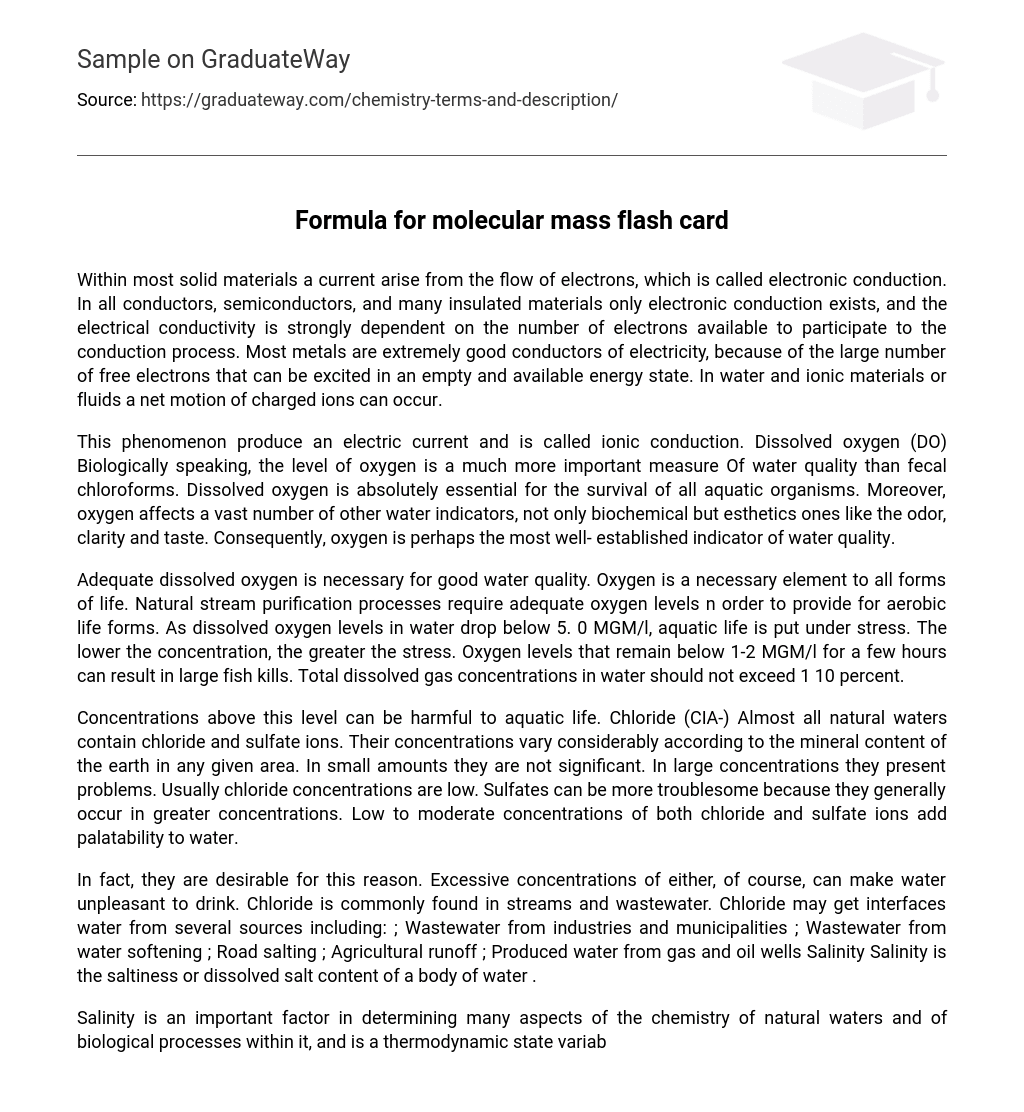Within most solid materials a current arise from the flow of electrons, which is called electronic conduction. In all conductors, semiconductors, and many insulated materials only electronic conduction exists, and the electrical conductivity is strongly dependent on the number of electrons available to participate to the conduction process. Most metals are extremely good conductors of electricity, because of the large number of free electrons that can be excited in an empty and available energy state. In water and ionic materials or fluids a net motion of charged ions can occur.
This phenomenon produce an electric current and is called ionic conduction. Dissolved oxygen (DO) Biologically speaking, the level of oxygen is a much more important measure Of water quality than fecal chloroforms. Dissolved oxygen is absolutely essential for the survival of all aquatic organisms. Moreover, oxygen affects a vast number of other water indicators, not only biochemical but esthetics ones like the odor, clarity and taste. Consequently, oxygen is perhaps the most well- established indicator of water quality.
Adequate dissolved oxygen is necessary for good water quality. Oxygen is a necessary element to all forms of life. Natural stream purification processes require adequate oxygen levels n order to provide for aerobic life forms. As dissolved oxygen levels in water drop below 5. 0 MGM/l, aquatic life is put under stress. The lower the concentration, the greater the stress. Oxygen levels that remain below 1-2 MGM/l for a few hours can result in large fish kills. Total dissolved gas concentrations in water should not exceed 1 10 percent.
Concentrations above this level can be harmful to aquatic life. Chloride (CIA-) Almost all natural waters contain chloride and sulfate ions. Their concentrations vary considerably according to the mineral content of the earth in any given area. In small amounts they are not significant. In large concentrations they present problems. Usually chloride concentrations are low. Sulfates can be more troublesome because they generally occur in greater concentrations. Low to moderate concentrations of both chloride and sulfate ions add palatability to water.
In fact, they are desirable for this reason. Excessive concentrations of either, of course, can make water unpleasant to drink. Chloride is commonly found in streams and wastewater. Chloride may get interfaces water from several sources including: ; Wastewater from industries and municipalities ; Wastewater from water softening ; Road salting ; Agricultural runoff ; Produced water from gas and oil wells Salinity Salinity is the saltiness or dissolved salt content of a body of water .
Salinity is an important factor in determining many aspects of the chemistry of natural waters and of biological processes within it, and is a thermodynamic state variable that, along with temperature and pressure, governs physical characteristics like the density and heat capacity of the water. Salinity in fivers, lakes, and the ocean is conceptually simple, but technically challenging to define and measure precisely. Conceptually the salinity is the quantity of dissolved salt content of the water.
Salts are compounds like sodium chloride, magnesium sulfate, potassium nitrate, and sodium bicarbonate which dissolve into ions. Operationally, dissolved matter is defined as that which can pass through a very fine filter Salinity can be expressed in the form of a mass fraction, I. E. The mass of the dissolved material in a unit mass of solution. Total Dissolved Solid (ADS) Total Dissolved Solids (ADS) are the compounds in the water that cannot be removed by a traditional filter. ADS are made up of salts or compounds which dissociate in water to form ions.
This means that a salt has two parts, one with a positive charge and one with a negative charge, which separate and mix with the water (H2O) molecules. Total dissolved solids (ADS) is a measure of the combined content of all inorganic and organic substances contained in a liquid in molecular, unionized or micro-granular suspended form. Primary sources for ADS in receiving waters are agricultural and residential runoff, caching of soil contamination and point source water pollution discharge from mind Austria or sewage treatment plants.
The most common chemical constituents are calcium, phosphates, nitrates, sodium, potassium and chloride, which are found in nutrient runoff, general storm water runoff and runoff from snowy climates where road De-icing salts are applied. The chemicals may be actions, anions, molecules or agglomerations on the order of one thousand or fewer molecules, so long as a soluble micro-granule is formed. More exotic and harmful elements of ADS are pesticides arising from reface runoff.
Certain naturally occurring total dissolved solids arise from the weathering and dissolution of rocks and soils Total suspended solid (TTS) TTS are solid materials, including organic and inorganic, that are suspended in the water. These would include silt, plankton and industrial wastes. High concentrations of suspended solids can lower water quality by absorbing light. Waters then become warmer and lessen the ability of the water to hold oxygen necessary for aquatic life. Because aquatic plants also receive less light, photosynthesis decreases and less oxygen is produced.





